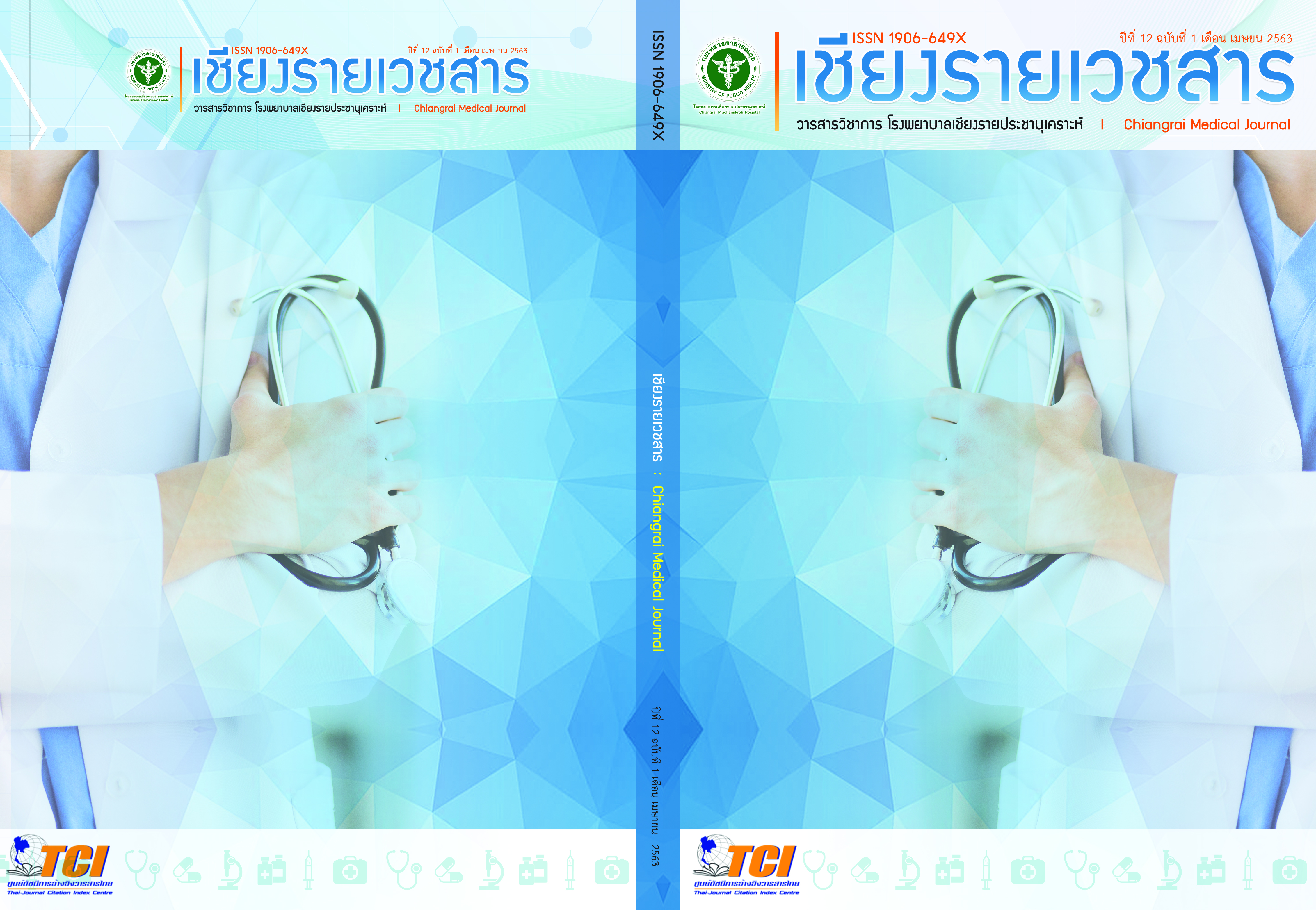ความชุกและปัจจัยเสี่ยงต่อการเกิดภาวะซึมเศร้าในผู้ป่วยเอดส์โรงพยาบาลแม่สาย
Main Article Content
บทคัดย่อ
ความเป็นมา ภาวะซึมเศร้าเป็นปัญหาสุขภาพจิตแฝงเร้นที่สำคัญ การศึกษาความชุกของภาวะซึมเศร้าที่โรงพยาบาลศรีนครินทร์ จังหวัดขอนแก่นในปี พ.ศ. 2555 พบร้อยละ 42.05 ในผู้ป่วยโรคเรื้อรัง และ ร้อยละ 44.70 ในผู้ป่วยเอดส์ ซึ่งจะส่งผลเสียต่อการรักษาโรค ภาวะซึมเศร้าอาจจะมีความรุนแรงมากขึ้น และส่งผลให้เกิดการพยายามฆ่าตัวตายได้ หากไม่ได้รับการจัดการอย่างเหมาะสม การค้นหาผู้ป่วยตั้งแต่ระยะเริ่มแรกจะเป็นกระบวนการที่มีประสิทธิภาพสูงสุดในมาตรการป้องกันโรค
วัตถุประสงค์ เพื่อศึกษาความชุกและปัจจัยเสี่ยงต่อการเกิดภาวะซึมเศร้าในผู้ป่วยเอดส์ในโรงพยาบาลชุมชนแห่งหนึ่งในจังหวัดเชียงราย
วิธีการศึกษา รูปแบบการศึกษา แบบภาคตัดขวางในผู้ป่วยเอดส์ที่มารับยาต้านไวรัส HIV ช่วงเวลาตั้งแต่ 1-31 มีนาคม 2563 ภาวะซึมเศร้าแบ่งเป็น 3 ระดับคือ (1) กลุ่มที่ไม่มีภาวะซึมเศร้าจากการคัดกรองและให้ผลลบต่อแบบประเมิน 2 ข้อคำถาม (2Q=negative) (2) กลุ่มที่มีคะแนนน้อยกว่า 7 จากการประเมินด้วยแบบประเมิน 9 ข้อคำถาม (9Q) และ (3) กลุ่มที่มีคะแนนตั้งแต่ 7 ขึ้นไปจากการประเมิน 9Q วิเคราะห์ปัจจัยเสี่ยงด้วยสถิติ Univariable และ stepwise multivariable ordinal logistic regression นำเสนอด้วย odds ratio (OR) และ 95% confidence interval (CI) หาความสามารถในการทำนายด้วย พื้นที่ใต้โค้ง Receiver Operating characteristic Curve (ROC)
ผลการศึกษา ผู้ป่วยติดเชื้อเอชไอวีทั้งหมด 161 ราย พบความชุกของภาวะซึมเศร้า ร้อยละ 11.8 จำแนกระดับความรุนแรง เล็กน้อย (ร้อยละ 10.56) ปานกลาง (ร้อยละ 1.24) ไม่พบระดับรุนแรง จากการวิเคราะห์ด้วย Univariable and stepwise multivariable ordinal logistic regression พบปัจจัยที่มีความสัมพันธ์กับภาวะซึมเศร้าอย่าง
มีนัยสำคัญทางสถิติ 4 ตัวแปร ได้แก่ เพศหญิง (adjusted OR=2.37; 95%CI 1.22-4.59, p=0.011) การมีผู้ดูแล (adjusted OR=3.54; 95%CI 1.07-11.72, p=0.038) การมีเหตุการณ์กระทบกระเทือนจิตใจอย่างรุนแรง (adjusted OR= 2.27; 95%CI 1.08-4.75, p=0.029) ระยะเวลาตั้งแต่ติดเชื้อ HIV >10 ปี เมื่อเทียบกับ 1-5 ปี (adjusted OR=0.42; 95%CI 0.20-0.87, p=0.020) ความสามารถในการทำนาย จากพื้นที่ใต้โค้ง (ROC) ร้อยละ 74.6
สรุปผลและข้อเสนอแนะ ผลการศึกษานี้พบความชุกของภาวะซึมเศร้าในผู้ป่วยเอดส์ ร้อยละ 11.8 พบปัจจัยเสี่ยงคือ เพศหญิง การมีผู้ดูแล การมีเหตุการณ์กระทบกระเทือนจิตใจอย่างรุนแรง และปัจจัยที่เกิดภาวะซึมเศร้าน้อยกว่าคือระยะเวลาตั้งแต่ติดเชื้อ HIV >10 ปี เมื่อเทียบกับ 1-5 ปี ซึ่งควรใช้ปัจจัยเหล่านี้ในการจัดกลุ่มเป้าหมายที่เหมาะสมในการติดตามเฝ้าระวังภาวะซึมเศร้าต่อไป
Article Details
เอกสารอ้างอิง
Wongsuraprakit S, Santiprasitkul S. Situation of depression in Pre-Screened risk Groups in Muang District, Chiang Rai Province. JTNMC 2012; 27(3): 91-105.
Jarassaeng N, Mongkolthawornchai S, Buntakheaw P, Hanlakhon P, Bunjun S, Arunponpaisal S. Depression in Chronic Illnesses at the OPD Section in Srinagarind Hospital, Faculty of Medicine, Khon Kaen university. J psychiatr Assoc Thailand 2012; 57(4): 439-46.
Hungsaitong T. The prevalence of depressive disorder, anxiety disorder and the risk associated among AIDS patient whom treatment in Wat Prabat Numpu, Lopburi province[dissertation]. Bangkok: Chulalongkorn university; 2002.
Jaisuda M, Ruanjai T. Prevalence of Depressive Mood and Related Factors among HIV/AIDS Patients at Somdej Phrayanasangworn Hospital, Chiang Rai. LMJ 2017; 38(2): 39-48.
Joon YS, Jin SL, Yu BS, Kim, In SK, Ji YN, Ji HB, et al. Depression Among HIV-infected Patients in Korea: Assessment of Clinical Significance and Risk Factors. Infect Chemother 2013; 45(2): 211-6.
Anagnostopoulos A, Ledergerber B, Jaccard R, Shaw SA, Stoeckle M, Bernasconi E, et al. Frequency of and Risk Factors for Depression among Participants in the Swiss HIV Cohort Study. PLoS One 2015; 10(1): 1-17.
Dew MA, Becker JT, Sanchez J, Caldararo R, Lopez OL, Wess L, et al. Prevalence and predictors of depression, anxiety and substance use disorders in HIV-infected and uninfected men: a longitudinal evaluation. Psychol Med 1997; 27(2): 395-409.
Bing EG, Bumam MA, Longshore D, Fleishman JA, Sherbourne CD, London AS, et al. Psychiatric disorders and drug use among human immunodeficiency virus-infected adults in the United States. Arch Gen Psychiatry 2001; 58(8): 721-8.
Oko RE, Awosan KJ, Oche MO, Yunusa MA. Prevalence and pattern of depression among HIV positive on treatment at the ART clinic of UDUTH, Sokoto, Nigeria. Int J Med Med Sci 2019; 1(1): 8-15.
Kongsuk T, Arunpongpaisal S, Janthong S, Prukkanone B, Sukhawaha S, Leejongpermpoon J. Criterion-related Validity of the 9 Questions Depression Rating scale revised for Thai Central Dialect. J Ment Health Thai 2018; 63(4): 321-34.
Beyene GA, Fekede EA. Prevalence and associated factors of depression among HIV patients taking antiretroviral therapy at Zewditu Memorial Hospital, Addis Ababa, Ethiopia. Int J Sci Study 2016; 3(4): 81-6.
Reis RK, Melo ES, Castrighini CD, Galvao MT, Malaguti SE, Gir E. Prevalence and factors associated with depressive symtoms in individuals living with HIV/AIDS. Salud Ment 2017; 40(2): 27-31.
Chikezie UE, Otakpor AN, Kuteyi OB, James BO. Depression among people living with human immunodeficiency virus infection/acquired immunodeficiency syndrome in Benin City, Nigeria: A comperative study. Niger J Clin Pract 2013;16(2): 238-42.
Pilukpakawat T. Prevalence of depression and factors correlated among children and adolescent patients with HIV infection. J Ment Health Thai 2014; 22(3): 186-94.
Liu H, Zhao M, Ren J, Qi X, Sun H, Qu L, et al. Identifying factors associated with depression among men living with HIV/AIDS and undergoing antiretroviral therapy: a cross sectional study in Heilongjiang, China. Health Qual Life Out 2018; 16(1): 190-5.
Vitsanuyotin S, Itthivitsawakul N. The clinical practice guideline for depressive disorder. The JBCNM 2010; 16(1): 5-22.
Onyebueke GC, Okwaraji FE. Depression and Suicide risk among HIV Positive Individual Attening an Out Patient HIV/AIDS Clinic of a Nigerian Tertiary Health Institution. J Psychiatry 2014; 18(1): 14-54.


